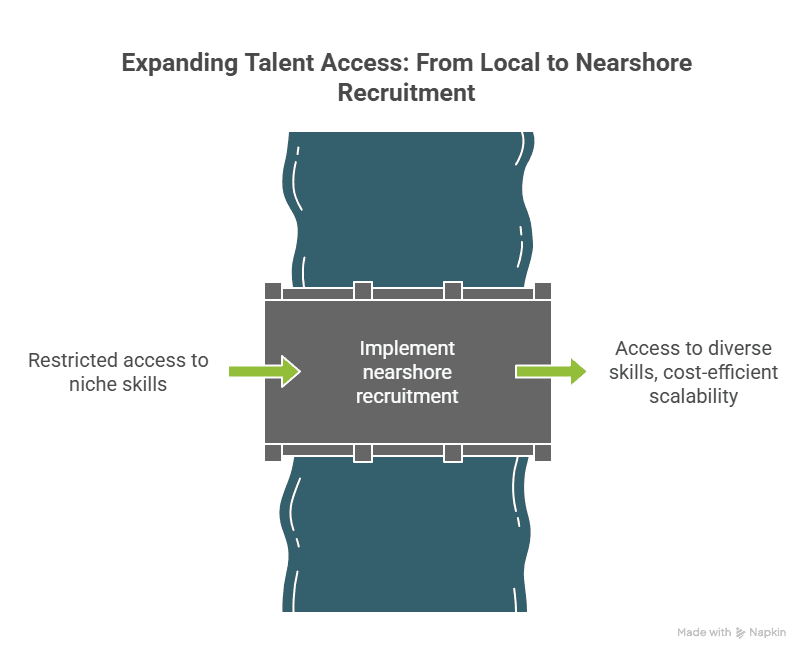What is the main difference between inshoring and nearshoring? The main difference is that inshoring keeps operations within the same country, while nearshoring moves them to a nearby country with similar time zones.
Each model has unique advantages depending on your organization’s priorities, like budget constraints or project complexity.
By grasping these key differences, you can make informed decisions that align with your company’s growth strategy. Whether you’re optimizing for scalability or enhancing team integration, knowing when to leverage inshore versus nearshore resources will help you achieve long-term success.
Let’s learn more.
What is inshore recruitment?
Inshore recruitment involves sourcing candidates within your country’s borders. Recruiters screen local talent pools to ensure cultural alignment, language fluency, and time zone compatibility. This model simplifies real-time communication during interviews or onboarding sessions. Hiring managers often prefer inshore recruitment for roles requiring deep knowledge of domestic markets or compliance with national regulations.
For example, a US-based company hiring software developers through an inshore staffing agency benefits from shared legal frameworks and immediate accessibility for team collaboration.
What is nearshore recruitment?
Nearshore recruitment connects businesses with candidates from nearby countries. Staffing agencies source talent across neighboring regions where labor costs are lower but skills remain competitive. Proximity enables smoother coordination compared to offshore models while offering cost advantages over inshore hiring.
If you’re an American CEO seeking digital marketing specialists, nearshoring to Colombia or Egypt provides access to skilled professionals at reduced rates without sacrificing overlapping work hours or regional familiarity.
Inshore vs Nearshore Comparison
This comparison highlights how each model impacts factors like budget management, candidate accessibility, and operational efficiency.
Pros and Cons of Inshore Hiring
Inshore hiring focuses on sourcing, recruiting, and onboarding candidates within your country. This model aligns closely with domestic business operations but carries specific advantages and disadvantages.
Advantages
- Cultural alignment
Inshore hiring ensures employees share the same cultural context as your organization. Recruiters can source talent familiar with local work ethics, communication styles, and market preferences. This minimizes miscommunication during team collaboration or client interactions.
- Regulatory compliance
Hiring managers benefit from streamlined processes when adhering to national labor laws, tax regulations, and employment standards. Onboarding becomes more efficient since contracts comply with local legal frameworks.
- Real-time communication
Employees operate in the same time zone as your business, enabling seamless scheduling for interviews, meetings, and project updates. This improves responsiveness across departments.
- Market expertise
Candidates sourced locally often possess deep knowledge of domestic markets. CEOs seeking roles like sales executives or marketing specialists gain access to professionals who understand regional consumer behavior.
- Employee retention
Retaining employees is easier when they feel connected to a shared culture and workplace environment. Local hires typically integrate faster into company teams compared to nearshore counterparts.
Disadvantages
- Higher costs
Recruiting inshore talent involves higher salary expectations due to developed-market wage standards. Hiring managers may face increased expenses for benefits packages, office space allocation, or relocation assistance if applicable.
- Limited talent pool
Sourcing domestically restricts access to global candidates with specialized skills unavailable locally. For niche technical roles requiring advanced programming languages or certifications, this limitation can delay recruitment timelines.
- Scalability challenges
Scaling operations quickly becomes difficult when relying solely on inshore hiring models because of limited workforce availability in certain regions or industries experiencing high demand.
- Competition for top talent
Companies operating within the same geographic area compete heavily for skilled professionals in fields like IT development or engineering services. Attracting qualified candidates requires offering competitive salaries and perks that strain budgets further.
Pros and Cons of Nearshore Hiring
Nearshore hiring connects your business with talent in neighboring countries, offering a balance between cost efficiency and operational alignment. Understanding its advantages and disadvantages helps you evaluate whether this model aligns with your recruitment goals.
Advantages
- Cost Efficiency
Nearshore hiring reduces labor costs compared to inshore models while avoiding the significant savings-to-coordination trade-offs seen in offshore outsourcing. For example, nearshore staffing agencies often offer competitive rates without compromising on quality.
- Time Zone Overlap
Proximity ensures overlapping work hours, enabling real-time communication during sourcing, screening, and onboarding processes. This minimizes delays in candidate evaluations or team integration.
- Cultural Alignment
Candidates from nearby regions often share similar cultural values or workplace norms, simplifying collaboration among employees across borders. This fosters smoother job matching and higher retention rates.
- Access to Larger Talent Pools
Expanding recruitment efforts to neighboring countries increases access to specialized skills unavailable domestically. Hiring managers can source niche professionals for roles like software development or multilingual customer support.
- Scalability
Nearshoring allows businesses to scale operations quickly by delegating tasks like vetting candidates or managing shortlisting pipelines to external partners familiar with regional markets.
Disadvantages
- Regulatory Compliance Challenges
Cross-border hiring introduces complexities around tax laws, employment regulations, and contractual agreements that recruiters must manage carefully during onboarding processes.
- Language Barriers
While less pronounced than offshore models, minor language differences may impact clarity during interviews or training sessions if not addressed early through effective communication strategies.
- Dependence on External Agencies
Relying heavily on nearshore staffing agencies for sourcing and screening could reduce control over recruitment quality unless performance metrics are actively tracked and optimized.
4. Limited Market Knowledge
Candidates sourced from other countries may lack familiarity with domestic markets, requiring additional training before they contribute fully to strategic objectives set by hiring managers or executives.
When to Choose Inshore vs Nearshore
Opt for Inshore Recruitment When:
- Cultural Alignment is Critical
Select inshore recruitment if your roles demand seamless integration into your company culture. Employees sourced domestically share cultural norms, work ethics, and communication styles that reduce onboarding friction.
- Regulatory Compliance is a Priority
Use inshore hiring when strict adherence to national labor laws or industry-specific regulations is essential. Domestic candidates simplify compliance processes during contract creation and payroll management.
- Real-Time Collaboration is Necessary
Hire inshore talent for positions requiring immediate responses or overlapping working hours with existing teams. This ensures faster decision-making and project execution without time zone constraints.
- Market Expertise Drives Success
Recruit locally for roles involving deep knowledge of domestic markets, such as sales teams or marketing experts targeting local audiences.
- Retention Rates are Key Metrics
Focus on inshore recruitment if employee retention significantly impacts your business outcomes. Familiarity with the local job market often results in longer tenures and reduced turnover rates.
Choose Nearshore Recruitment When:
- Cost Efficiency Impacts Budgets
Leverage nearshore staffing agencies to access skilled professionals at lower costs compared to domestic hires while maintaining quality standards.
- Scalability Supports Growth Goals
Deploy nearshore models when scaling operations quickly requires flexible workforce solutions without long-term commitments tied to full-time employees.
- Time Zone Overlap Enhances Productivity
Source candidates from neighboring countries where working hours align closely with yours, enabling real-time collaboration similar to inshore setups but at reduced expenses.
- Larger Talent Pools Solve Hiring Challenges
Tap into broader candidate pools through nearshoring if local sourcing limits options for specialized skills like software development or multilingual customer support roles.
- Project-Based Needs Dominate Recruitment Plans
Contract nearshore professionals for short-term projects demanding specific expertise without incurring high overhead costs associated with permanent staff placements.
By aligning these factors with your organizational priorities, you can determine whether an inshore or nearshore model better supports your recruitment strategy’s objectives and operational needs.
Talent Pool Availability and Skill Access

Inshore recruitment provides access to a smaller, localized talent pool. Recruiters often source candidates with deep knowledge of domestic markets, ensuring cultural alignment and compliance with national regulations. But, this limited geographic scope can restrict the availability of niche skills or specialized expertise, particularly in industries requiring advanced technical capabilities.
Nearshore recruitment expands your reach to larger talent pools in neighboring countries. Hiring managers can screen and evaluate candidates with diverse skill sets while maintaining time zone compatibility for seamless collaboration. This model offers greater flexibility for scaling teams and filling roles that demand specific technical proficiencies, such as software development or multilingual customer support.
Recruiting through nearshore staffing agencies also enables you to attract highly skilled professionals at competitive rates compared to inshore hiring.
These agencies streamline processes like candidate shortlisting and job matching, reducing time-to-hire without compromising quality. In contrast, inshore models may involve higher competition for top-tier talent due to regional constraints, increasing both costs and hiring timelines.
Analyzing your operational needs helps determine which model aligns better with your goals. If sourcing local market experts is critical, inshore recruitment ensures regulatory compliance and cultural fit. For broader skill access or cost-efficient scalability, nearshore recruitment optimizes resource allocation while maintaining effective team integration across borders.
Still Debating Inshore vs. Nearshore? Your Competitors Aren’t.
If you’re spending weeks deciding between local hires and nearshore talent, you’re already behind. Inshore might feel comfortable, but it’s expensive, slow to scale, and limited in reach.
Nearshoring gives you access to skilled professionals who work your hours, understand your market, and cost a fraction of what you’d pay locally. It’s not a workaround. It’s the smarter, faster way to build high-performance teams.
Scale Army is the international staffing partner smart U.S. businesses trust to scale without the bloat. We don’t send resumes. We build teams that deliver.
Still hiring the old way? That’s your competition’s favorite strategy.
Book a strategic call with Scale Army—before they do.
Frequently Asked Questions
What is the difference between inshore and nearshore outsourcing?
Inshore outsourcing involves working with providers within the same country, ensuring cultural alignment, regulatory compliance, and real-time communication. Nearshore outsourcing connects businesses with talent from nearby countries, offering cost savings, time zone overlap, and access to larger talent pools.
When should a company choose inshore recruitment?
Inshore recruitment is ideal when cultural alignment, regulatory compliance, market expertise, real-time collaboration, or employee retention are critical for business operations.
What are the advantages of nearshore hiring?
Nearshore hiring offers benefits like cost efficiency, time zone compatibility for seamless communication, access to larger talent pools, scalability for growing teams, and cultural similarities compared to offshore models.
Are there any disadvantages to inshore recruitment?
Yes. Inshore recruitment can be more expensive due to higher labor costs. It also has a smaller talent pool and may face challenges with scalability and competition for top-tier candidates.
How does nearshore recruitment help reduce costs?
Nearshore recruitment reduces costs by leveraging lower labor rates in neighboring countries while maintaining proximity that minimizes travel expenses and ensures smoother collaboration compared to offshore options.
Is language a barrier in nearshore outsourcing?
Language barriers can occur in nearshore outsourcing depending on the region chosen. However, many nearshore locations prioritize English proficiency to facilitate effective communication with international clients.
Which model is better for accessing niche skills: inshore or nearshore?
Nearshore recruitment is better for accessing niche skills as it provides a broader talent pool across neighboring countries. In contrast, inshore models may have limited availability of specialized professionals within domestic markets.
Can both models support scalability effectively?
Yes. Nearshore models excel at scaling quickly due to larger talent pools and cost-efficient hiring processes. In contrast, inshore models may face limitations due to geographic constraints and higher competition for local talent.
How do time zones impact these outsourcing models?
Inshore outsourcing eliminates time zone issues since teams operate within the same country. Nearshore outsourcing offers minimal time zone differences, enabling smooth coordination without significant delays or scheduling conflicts.
What factors should businesses consider when choosing between these models?
Businesses should evaluate priorities such as budget constraints, need for cultural alignment or market expertise (in favor of inshore), versus goals like cost efficiency or team scalability (favoring nearshore). Aligning these factors with organizational objectives ensures optimal results.




